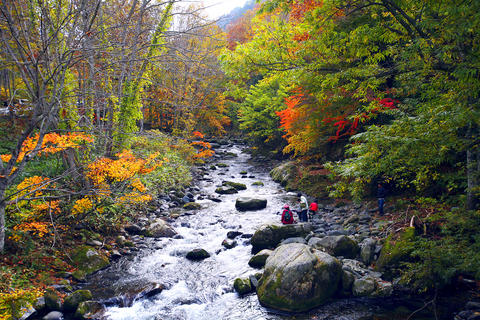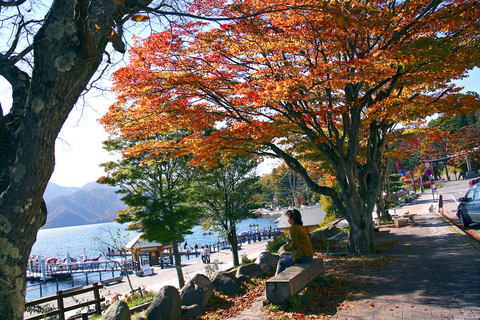Walk into any railway ticket office or travel agency in Japan these days, and there is a good chance it will be festooned with garlands of red paper leaves and plastered with enormous photographs of autumn landscapes, all exploding with color. Kouyou season is here.
Kouyou, which can be translated literally as "red leaves" or idiomatically as "changing colors," may be less well-known to international tourists, but it is as important to the Japanese as their fabled cherry blossom festival in the spring. It is a time of dazzling beauty, with streaks of red, orange, yellow and gold splashed across vast areas of the countryside. And it takes place during one of the best times to visit Japan, between the stifling humidity of the summer and the chill of winter.
"There are four distinct seasons in Japan," said Eiichi Ito, director of the Visit Japan Campaign secretariat, a tourism coordinating group. "We recommend spring and autumn, because the weather is very fine and the season is so beautiful."

PHOTOS: NY TIMES NEWS SERVICE
The season is longer, too. Though cherry trees can bloom and then lose their blossoms within the span of a week or less in the spring, the changing of the colors in fall occurs over more than two months across Japan. The earliest changes take place in late September at high altitudes, where temperatures are lower, and on the northern island of Hokkaido. But the colors are still on show in the south and west of the country in late November.
The most intense colors come out in areas where the temperature drops most suddenly, said Jin Murata, a professor and curator of the botanical gardens at the University of Tokyo. "If the change is slow, the color is not so beautiful," he said.
The most famous kouyou trees are probably the Japanese maple, whose leaves turn bright red, and the ginkgo — a Chinese import, as Murata pointed out — whose leaves turn yellow. But plenty of others put in an appearance: beeches, lacquer trees, and even those cherry trees, whose leaves can take on a fiery golden color.

Murata added that the longer season and range of color were because of the variety of trees in Japan, since different species react to the climate changes with different timing.
The changes don't happen at the same time in the same place every year, though, said Hiroko Ueno, assistant manager of the Tourist Information Center of the Japan National Tourist Organization in Tokyo. Last year, for example, higher temperatures pushed the kouyou later into October and November. But this year, she said, "I feel a little bit cooler."
Color changes typically take several days for a given tree, Murata said. A Japanese maple can take at least two weeks. So there is some leeway in planning a kouyou trip. Indeed, it's a good idea to get a head start on your sightseeing because the crowds can be enormous. The area called Qurankei, in Aichi prefecture, for example, is always popular. At the peak of the season there, cars and buses streaming toward the prime viewing sites can cause gridlock, especially on weekends.
If you're already in Japan during kouyou season, chances are you'll be near a good place to see some spectacular foliage. Ueno recommended a number of kouyou locations, from the top to the bottom of the country. They include the slopes of the Daisetsu volcano group on Hokkaido, in the north, which give a colorful showing relatively early in the season; and Kankakei Gorge, a valley on Shodoshima Island in Japan's Inland Sea, which turns flaming red and is visible from the island's cable cars. Well-known tourist destinations like Kyoto, Kamakura, Nara and Hakone also offer great kouyou possibilities, Ueno said. But if you're stuck in Tokyo on business, you still have plenty of options.
The city's parks offer a wide range of trees and colors. The Inokashira Koen, near the train station of the same name, was the first park opened to the public by an emperor, when Taisho (known as Yoshihito during his reign) founded it in 1917. The Hibiya Koen, which is closest to the Kasumigaseki subway station, is a Western-style park with a great variety of trees, many of which have leaves that change color in the fall.
Ueno suggested the Rikugien, a traditional Japanese garden on land that was given by a 17th-century emperor to one of the noblemen who supported him. It's near Komagome station in the north of the city. Closer to the center, a short walk from the Shinbashi station, with a somewhat incongruous background of skyscrapers, is the Hama-Rikyu garden, which once housed a villa for the imperial family. One of the most striking sights is Jingu Gaien Street, which leads from Aoyama to the Meiji Kaigakan art museum (also called the Memorial Picture Gallery) through a double line of ginkgos. The street is just off Aoyama Dori in central Tokyo, near the Gaienmae subway station and the Shinanomachi train station.
For the Japanese, enjoying the kouyou season is a fairly low-key pursuit. Ito said that people typically went on hikes with their families or with co-workers, perhaps stopping at restaurants with views of the foliage. (In Tokyo, there are cafes with views near most of the parks.) There are also some traditional autumn snacks, like goheimochi, clumps of pasty rice broiled on sticks that are popular around Qurankei. But there is not a full-blown festival.
That's partly because kouyou season lasts so long; there isn't the urgency to celebrate as there is in cherry blossom season, Ueno said. "In spring, we drink and eat and dance till late at night. In autumn, we quietly appreciate it."
FIERY FOLIAGE IN A QUIETER SEASON
You don't have to be in Japan to find out when the colors are changing. There are several resources just a click or a phone call away. The Japan National Tourist Organization maintains a Web site with general guidelines at www.jnto.go.jp/eng (click on seasonal attractions, then seasonal highlights). A slightly more comprehensive version is available in Japanese, at kouyou.nihon-kankou.or.jp/.
For the most up-to-the-minute information, you can call the Tourist Information Center of the Japan National Tourist Organization in Tokyo. Every day, the center updates its own list of kouyou sightings, with a five-point rating scale that ranges through "not yet," "starting," "half," "suitable" and "end."
"We are networked with over 140 local information offices," said Ueno. "Day by day, or one by one, we collect this information."
The center is on the 10th floor of the Tokyo Kotsu Kaikan building, just across from the Yurakucho subway station in Tokyo; 81-3-3201-3331. It is open from 9am to 5pm daily.
In addition to Daisetsu and Kankakei Gorge, Ueno recommends the following places for fall color:
Matsushima. This city on the northeastern coast of the main island of Honshu looks out onto a bay sprinkled with 260 little islands.
Nikko. It's less than two hours from Tokyo by train, but some of the peaks in this scenic mountainous area rise to 2,438m. As a result, the season starts quite a bit earlier than in the low-lying cities. The region is also known for its combination of natural and man-made beauty, Ueno said, with temples and shrines in stunning settings.
Tateyama. In Honshu's Japanese Alps you can trek through fall colors on a "grand scale," Ueno said, with remarkable vistas from what's called "the roof of Japan."
Kanazawa. On the northern coast of Honshu, this castle town has one of the country's three most famous landscape gardens.
Miyajima Island. Located near Hiroshima in the Inland Sea, Miyajima is known for its temples and for Mount Misen, a holy site that also gives quite a kouyou show.
Takachiho Gorge. On Kyushu, the southernmost of the large islands, the changing colors of the leaves are mixed with ravines and rushing waterfalls.

This month the government ordered a one-year block of Xiaohongshu (小紅書) or Rednote, a Chinese social media platform with more than 3 million users in Taiwan. The government pointed to widespread fraud activity on the platform, along with cybersecurity failures. Officials said that they had reached out to the company and asked it to change. However, they received no response. The pro-China parties, the Chinese Nationalist Party (KMT) and Taiwan People’s Party (TPP), immediately swung into action, denouncing the ban as an attack on free speech. This “free speech” claim was then echoed by the People’s Republic of China (PRC),

Exceptions to the rule are sometimes revealing. For a brief few years, there was an emerging ideological split between the Democratic Progressive Party (DPP) and Chinese Nationalist Party (KMT) that appeared to be pushing the DPP in a direction that would be considered more liberal, and the KMT more conservative. In the previous column, “The KMT-DPP’s bureaucrat-led developmental state” (Dec. 11, page 12), we examined how Taiwan’s democratic system developed, and how both the two main parties largely accepted a similar consensus on how Taiwan should be run domestically and did not split along the left-right lines more familiar in

Specialty sandwiches loaded with the contents of an entire charcuterie board, overflowing with sauces, creams and all manner of creative add-ons, is perhaps one of the biggest global food trends of this year. From London to New York, lines form down the block for mortadella, burrata, pistachio and more stuffed between slices of fresh sourdough, rye or focaccia. To try the trend in Taipei, Munchies Mafia is for sure the spot — could this be the best sandwich in town? Carlos from Spain and Sergio from Mexico opened this spot just seven months ago. The two met working in the

Many people in Taiwan first learned about universal basic income (UBI) — the idea that the government should provide regular, no-strings-attached payments to each citizen — in 2019. While seeking the Democratic nomination for the 2020 US presidential election, Andrew Yang, a politician of Taiwanese descent, said that, if elected, he’d institute a UBI of US$1,000 per month to “get the economic boot off of people’s throats, allowing them to lift their heads up, breathe, and get excited for the future.” His campaign petered out, but the concept of UBI hasn’t gone away. Throughout the industrialized world, there are fears that